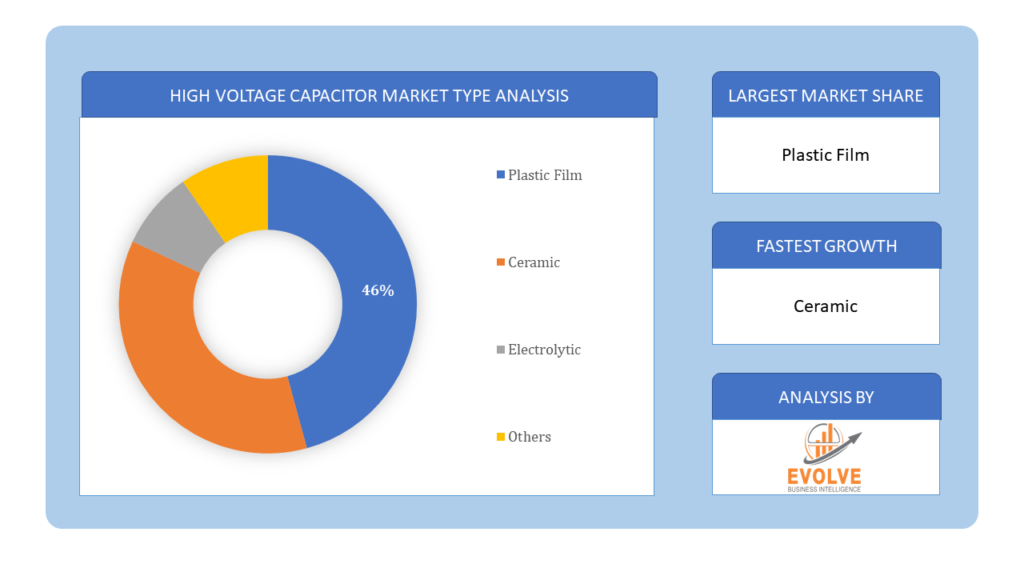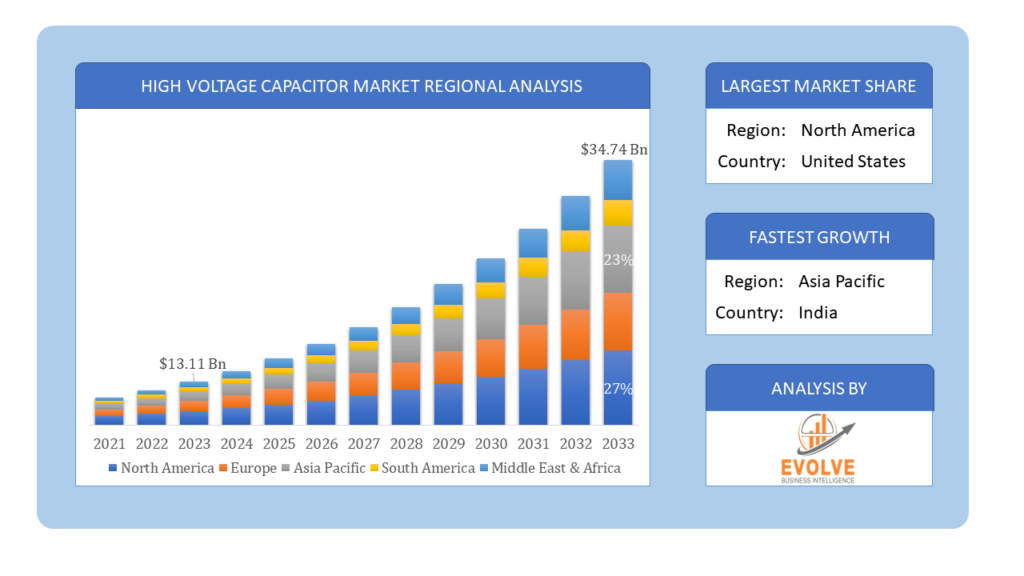High Voltage Capacitor Market Overview
The High Voltage Capacitor Market Size is expected to reach USD 34.74 Billion by 2033. The High Voltage Capacitor Market industry size accounted for USD 13.11 Billion in 2023 and is expected to expand at a compound annual growth rate (CAGR) of 9.87% from 2023 to 2033. The High Voltage Capacitor Market refers to the sector of the electronics industry that deals with the production, distribution, and sale of capacitors designed to handle high voltage applications. Capacitors are electronic components used to store and release electrical energy. In high voltage applications, such as power transmission, electrical equipment, medical devices, and automotive systems, capacitors need to withstand and manage significant voltage levels safely and efficiently.
Factors influencing the high voltage capacitor market include technological advancements, demand from emerging industries such as electric vehicles and renewable energy, regulatory standards, and evolving consumer needs for efficiency and reliability. Additionally, factors like miniaturization, cost-effectiveness, and environmental sustainability play significant roles in shaping market trends and product development within this sector.
Global High Voltage Capacitor Market Synopsis
The COVID-19 pandemic had several impacts on the High Voltage Capacitor Market. Many manufacturers faced disruptions in the supply chain due to lockdowns, travel restrictions, and closures of manufacturing facilities. This led to delays in production and shipment of high voltage capacitors. Demand for high voltage capacitors varied across different sectors. While certain industries like automotive and aerospace experienced a downturn in demand due to reduced production and sales, other sectors such as healthcare (medical devices) and energy (power distribution) saw sustained or increased demand. The pandemic accelerated the trend of digitalization in various industries. This increased the demand for high voltage capacitors used in electronic devices, communication systems, and data centers to support remote work, online education, and digital connectivity. The uncertainty caused by the pandemic might have led some companies to reassess their investment plans for research, development, and expansion in the high voltage capacitor market. This could have both short and long-term implications for innovation and market competitiveness.
High Voltage Capacitor Market Dynamics
The major factors that have impacted the growth of High Voltage Capacitor Market are as follows:
Drivers:
Ø Advancements in Power Electronics
Continuous advancements in power electronics technologies, including inverters, converters, and motor drives, require high voltage capacitors to ensure reliable operation and performance. These capacitors are essential for applications such as motor drives, uninterruptible power supplies (UPS), and grid-tied inverters. Infrastructure projects related to power transmission and distribution, smart grid systems, and electrification initiatives in developing regions are driving the demand for high voltage capacitors. These capacitors are used in transformers, switchgear, circuit breakers, and other electrical equipment to improve efficiency and reliability. The expansion of telecommunications networks and the increasing demand for data centers require high voltage capacitors for power conditioning, voltage regulation, and energy storage. Capacitors used in these applications help ensure stable and reliable operation of critical infrastructure for communication and data processing.
Restraint:
- Perception of High Cost of Materials
High voltage capacitors often require specialized materials with high dielectric strength and reliability, which can contribute to higher manufacturing costs. Fluctuations in material prices can further impact production costs and profit margins for manufacturers. The high voltage capacitor market is characterized by a few dominant players with significant market share. Market consolidation through mergers and acquisitions can reduce competition and limit opportunities for smaller manufacturers to enter the market. The demand for high voltage capacitors is closely tied to end-use industries such as automotive, telecommunications, and industrial automation, which may experience cyclicality due to economic conditions, technological disruptions, or regulatory changes.
Opportunity:
⮚ Growing demand for Renewable Energy Integration
With the global shift towards renewable energy sources such as solar and wind power, there’s a growing need for high voltage capacitors in energy storage systems, grid stabilization, and power electronics. Capacitors play a crucial role in improving the efficiency and reliability of renewable energy generation and distribution, presenting significant opportunities for market expansion. The rapid adoption of electric vehicles (EVs) worldwide requires the development of robust charging infrastructure. High voltage capacitors are essential components in EV charging stations, providing energy storage, voltage regulation, and power conditioning capabilities. As the EV market continues to grow, there’s a considerable opportunity for high voltage capacitor manufacturers to supply components for charging infrastructure expansion.
High Voltage Capacitor Market Segment Overview
By Type
 Based on Type, the market is segmented based on Plastic Film, Ceramic, Electrolytic and Others. The plastic film capacitor segment dominated the market. This is linked to their versatility, high insulation resistance, and excellent stability over a wide range of temperatures.
Based on Type, the market is segmented based on Plastic Film, Ceramic, Electrolytic and Others. The plastic film capacitor segment dominated the market. This is linked to their versatility, high insulation resistance, and excellent stability over a wide range of temperatures.
By Capacity
Based on Capacity, the market segment has been divided into the 500-1,000V, 1001-7000V, 7,001-14,000V and Above 14,000V. The 1001-7000V segment dominated the market. Capacitors within this voltage range are suitable for High-Voltage applications in power distribution and transmission systems. They maintain voltage stability and reduce losses in long-distance power transmission.
By Application
Based on Application, the market segment has been divided into the Power Generation, Transmission, Distribution and Others. The power generation segment dominated the market. This is attributed to usage of High-Voltage capacitors in power generation systems. Capacitors are utilized in power plants for power factor correction, voltage stabilization, and reactive power compensation.
Global High Voltage Capacitor Market Regional Analysis
Based on region, the global High Voltage Capacitor Market has been divided into North America, Europe, Asia-Pacific, the Middle East & Africa, and Latin America. North America is projected to dominate the use of the High Voltage Capacitor Market followed by the Asia-Pacific and Europe regions.
 High Voltage Capacitor North America Market
High Voltage Capacitor North America Market
North America holds a dominant position in the High Voltage Capacitor Market. North America is likely to have a significant share of the high voltage capacitor market due to its strong industrial base, advanced technology adoption, and robust infrastructure. The United States and Canada are major contributors to the market, driven by demand from industries such as automotive, aerospace, telecommunications, and energy. The presence of leading high voltage capacitor manufacturers, research institutions, and technology hubs in North America further supports market growth and innovation.
High Voltage Capacitor Asia-Pacific Market
The Asia-Pacific region has indeed emerged as the fastest-growing market for the High Voltage Capacitor Market industry. Asia Pacific is expected to witness significant growth in the high voltage capacitor market, driven by rapid industrialization, urbanization, and infrastructure development in countries like China, Japan, South Korea, and India. China, in particular, is a major manufacturing hub for electronics, automotive, and renewable energy industries, contributing to the demand for high voltage capacitors. The increasing adoption of electric vehicles, expansion of telecommunications networks, and investments in renewable energy projects further fuel market growth in the region.
Competitive Landscape
The global High Voltage Capacitor Market is highly competitive, with numerous players offering a wide range of software solutions. The competitive landscape is characterized by the presence of established companies, as well as emerging startups and niche players. To increase their market position and attract a wide consumer base, the businesses are employing various strategies, such as Product launches, and strategic alliances.
Prominent Players:
- Walsin Technology
- Vishay Intertechnology Inc
- General Electric
- Eaton Corporation
- Maxwell Technologies
- Siemens AG
- Lifasa
- ABB Ltd.
- Taiyo Yuden
- Transgrid Solutions
Key Development
In April 2023: Kyocera Corporation announced the creation of a new capacitor (MLCC) with EIA 0201 dimensions (0.6 mm x 0.3 mm). With the increasing complexity of smartphones and wearable gadgets, there is a growing demand for electronic circuits that necessitate MLCC devices with higher capacitance values.
Scope of the Report
Global High Voltage Capacitor Market, by Type
- Plastic Film
- Ceramic
- Electrolytic
- Others
Global High Voltage Capacitor Market, by Capacity
- 500-1,000V
- 1001-7000V
- 7,001-14,000V
- Above 14,000V
Global High Voltage Capacitor Market, by Application
- Power Generation
- Transmission
- Distribution
- Others
Global High Voltage Capacitor Market, by Region
- North America
- US
- Canada
- Mexico
- Europe
- UK
- Germany
- France
- Italy
- Spain
- Benelux
- Nordic
- Rest of Europe
- Asia Pacific
- China
- Japan
- South Korea
- Indonesia
- Austalia
- Malaysia
- India
- Rest of Asia Pacific
- South America
- Brazil
- Argentina
- Rest of South America
- Middle East & Africa
- Saudi Arabia
- UAE
- Egypt
- South Africa
- Rest of Middle East & Africa
| Parameters | Indicators |
|---|---|
| Market Size | 2033: $34.74 Billion |
| CAGR | 9.87% CAGR (2023-2033) |
| Base year | 2022 |
| Forecast Period | 2023-2033 |
| Historical Data | 2021 |
| Report Coverage | Revenue Forecast, Competitive Landscape, Growth Factors, and Trends |
| Key Segmentations | Type, Capacity, Application |
| Geographies Covered | North America, Europe, Asia-Pacific, Latin America, Middle East, Africa |
| Key Vendors | Walsin Technology, Vishay Intertechnology Inc, General Electric, Eaton Corporation, Maxwell Technologies, Siemens AG, Lifasa, ABB Ltd., Taiyo Yuden and Transgrid Solutions. |
| Key Market Opportunities | • The growing demand for Renewable Energy Integration • Electric Vehicle Charging Infrastructure |
| Key Market Drivers | • Advancements in Power Electronics Telecommunications and Data Centers |
REPORT CONTENT BRIEF:
- High-level analysis of the current and future High Voltage Capacitor Market trends and opportunities
- Detailed analysis of current market drivers, restraining factors, and opportunities in the future
- High Voltage Capacitor Market historical market size for the year 2021, and forecast from 2023 to 2033
- High Voltage Capacitor Market share analysis at each Product level
- Competitor analysis with detailed insight into its Product segment, Government & Defense strength, and strategies adopted.
- Identifies key strategies adopted including Product launches and developments, mergers and acquisitions, joint ventures, collaborations, and partnerships as well as funding taken and investment done, among others.
- To identify and understand the various factors involved in the global High Voltage Capacitor Market affected by the pandemic
- To provide a detailed insight into the major companies operating in the market. The profiling will include the Government & Defense health of the company’s past 2-3 years with segmental and regional revenue breakup, Product soffering, recent developments, SWOT analysis, and key strategies.









